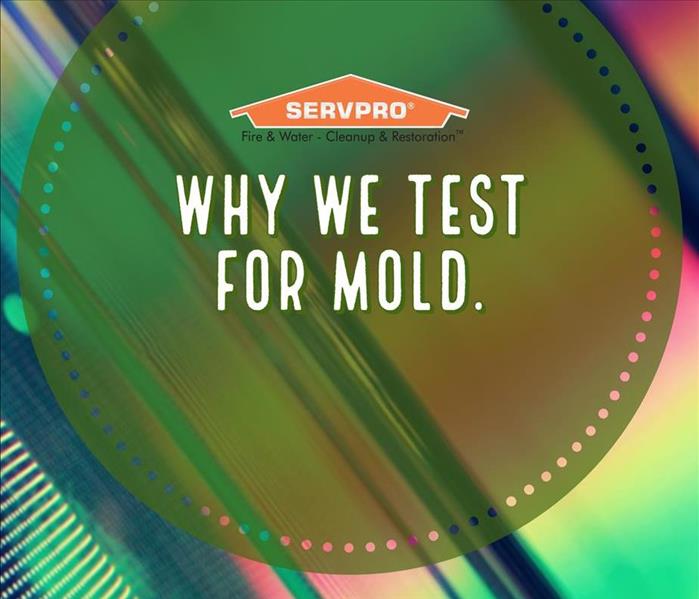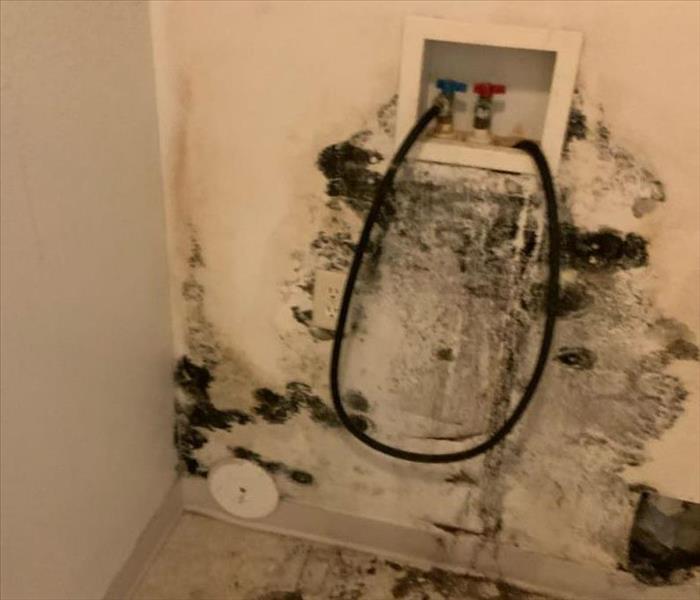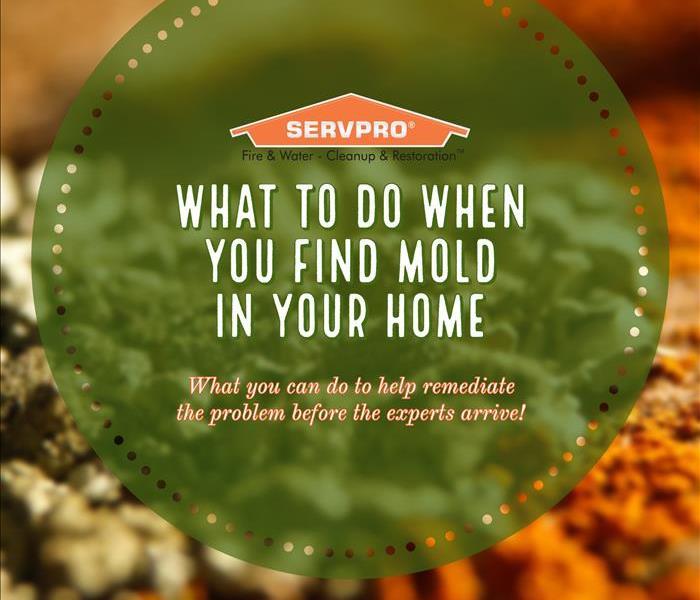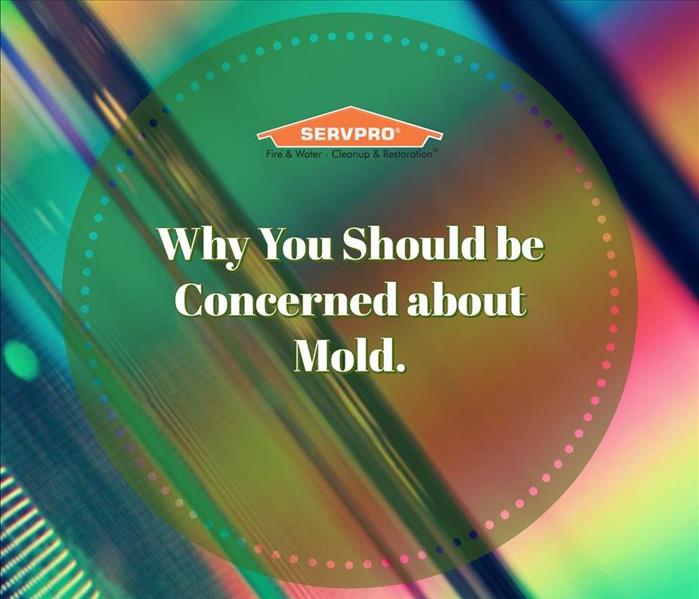Recent Mold Remediation Posts
Dealing with mold
7/13/2022 (Permalink)
Dealing with mold
Introduction
Mold is a mysterious and frightening problem to deal with, especially if you're not sure how to get rid of it. There are many different types of mold that can be found inside your home when you least expect it. Some types of mold are more harmful than others, so it's important to know what you're dealing with before trying to clean up the mess. In this guide we'll walk through the steps for cleaning up a small or medium size problem first, then expand outwards from there as needed!
Step 1: Check for mold.
The first step in dealing with mold is to find it. Mold starts growing when there is dampness and darkness, so look in the bathrooms, kitchens, laundry rooms and basements of your home. If you have an attic or crawl space that doesn't get much natural light, check these areas too. Be sure to check for black spots on pipes or walls as well as blue or green streaks on ceilings and walls.
Step 2: Identify the problem.
Mold can be found in many places. It can be the result of a water leak, and it often occurs in the bathroom, kitchen or other areas where moisture is common. If there is mold anywhere in your home, you need to take steps quickly to remove as much of it as you can before it spreads further and makes its way into your walls and flooring.
Step 3: Decide how much you can take on yourself.
If you're not sure about how to remove the mold, call a professional. It's always better to be safe than sorry when it comes to your health!
Step 4: Gather your tools and supplies.
Goggles
Paper mask (or bandana)
Dust mask, disposable or reusable filter masks
Rubber gloves, nitrile or latex
Tissues and paper towels, preferably few-ply
Step 5: Use separate tools for each room.
Now that you have a sense of the scope of the problem, it's time to decide what tools and products will be most helpful in removing mold from each room. This step might seem unnecessary, but trust us: it's not! The best way to avoid cross-contamination is by using different brushes or pads for each room.
Also, don't forget that some of your tools may need replacing now and then (especially if they've been exposed to moisture). You could also consider purchasing a few extra pieces which can be used throughout all rooms so as not to waste time by having to stop mid-job and go get another one.
Alternatively, if budget isn't an issue for you then there are other ways in which we can help prevent cross-contamination like using disposable wipes instead of rags or cloths (which may carry residual mold spores).
You'll also need a big bucket to mix the solution in and a spray bottle to apply it with, unless you're using premixed products, which are available at Builders Warehouse.
You'll also need a big bucket to mix the solution in and a spray bottle to apply it with, unless you're using premixed products, which are available at Builders Warehouse.
I recommend using an inexpensive 5-gallon paint bucket ($8) for mixing the solution. You can get away with smaller buckets if your room is smaller than 100 square feet or so, but larger ones are needed for larger rooms because they will allow you to mix up more product at once. The reason is that when using bleach, you have to add water slowly while stirring constantly until all of the bleach has been diluted into an even mixture. If the bucket is too small, then there won't be enough room for this process and some of your mixture may not get fully diluted before being sprayed onto surfaces in your home (and may end up causing damage because it contains un-diluted bleach).
Step 6: Cleaning and disinfecting.
Step 6: Cleaning and disinfecting.
Once you’ve identified the moldy area, it’s time to clean it. Mix a solution of one part bleach to 10 parts water in a spray bottle, then apply the solution directly to the moldy area using a paper towel or cloth. Let it sit for five minutes, then wipe clean with a second dry cloth.
Step 7: Deodorize and prevent future mold growth.
To deodorize the area, you can use bleach and water. Start by rinsing the area with clean water, then apply a mixture of one cup of household chlorine bleach to 1 gallon of water. Let this sit for at least 5 minutes before wiping up any excess solution. For best results, allow it to dry completely before using your space again.
If your mold problem is particularly severe or if it did not go away after cleaning (or if you have another type of resistant mold), bring in professionals who specialize in removing toxic molds from homes such as BioAir; these experts will be able to assess whether any additional steps are necessary.
In addition to cleaning the affected area(s) in your home thoroughly, there are several other things that can help prevent future mold growth:
Use a dehumidifier when possible and/or open windows during dry spells (e.g., when it’s raining outside). This will help keep humidity levels low enough for most molds not to grow inside buildings or homes where they otherwise would thrive on moist surfaces such as walls or ceilings--but take care not overdo it because too much moisture removal may cause condensation problems elsewhere within your building! If possible use both methods together; one without support from another approach will likely fail due towards lackadaisical results since nothing else exists which would serve as extra support aside from maybe frequent vacuuming maintenance schedule services."
Mold is an unsightly, expensive and sometimes hazardous problem that must be dealt with immediately
Mold growth is unsightly.
Mold growth can be expensive.
Mold growth can be hazardous to your health.
If you notice mold growth in your home, it must be dealt with immediately!
Conclusion
I hope this article has been helpful to you. If you're dealing with mold, it's important to act quickly and get rid of it as soon as possible. Remember that there are many different types of mold out there, so make sure you know what kind your home or office building has before starting any cleanup process!
Why You Should Purchase a Dehumidifier
2/23/2021 (Permalink)
When cleaning up water damage, commercial-grade dehumidifiers are excellent for sucking excess moisture from the air, helping to dry out the area and prevent further damage. While extraction of the standing water takes first priority, dehumidification prevents a variety of further problems such as improving air quality and reducing mold growth. If you don’t already have a dehumidifier, here are some benefits of why you should get one.
As mentioned in the paragraph above, the benefit of cleaner air is huge. Overly moist air is susceptible to catching a variety of airborne particles, contaminating your air. This could include dust, dead skin cells, and mold spores. Dehumidification reduces the number of particles in the air, making it easier and better for breathing.
Reducing moisture and maintain cleaner air is one of the best ways to prevent mold growth in your home. Mold grows by finding a damp, wet environment and then releases spores into the air which spread throughout your home until they find another surface to grow on. One of the reasons we at SERVPRO of Minot dehumidify areas that have been affected by water loss is to reduce the chance of mold growth.
While our commercial-grade dehumidifiers are excellent at removing large amounts of moisture from the air in homes and businesses, they are not affordable for the average person. However, many residential dehumidifiers are available that can be placed in a basement or other room and are specifically designed for a space of that size. Home dehumidifiers are affordable for most families and can be found in a variety of stores both online and in-person stores. If you have been considering buying a dehumidifier, there is no better time than now to make a purchase.
What to Do When You Find Mold in your Home
8/11/2020 (Permalink)
Discovering mold in your home can be a frustrating event. Not knowing how bad the problem is, how to remove it, the cost of a professional and whether or not your home is safe are just some of the thoughts you’ll have. To help relieve some of those worries, below are some tips to help manage your mold problem.
The first step to do is to call the mold experts at SERVPRO of Minot, we will immediately respond to your call and have staff on site to provide help and advice. Every discovery of growth is different and having experts take a look at it is important in deciding what to do next.
Until we are able to get staff on site, here are some tips on what to do.
Try and contain the area
If the growth is in a room that can be sealed off from the rest of the house. Air movement will spread the spores around and can lead to further growth throughout your home. Staying out of it until technicians can determine the extent of the problem is a good way to keep you and your family safe.
Stop the Source
Mold growth is accompanied by moisture from a leak or other water source. See if you can stop the leak or remove the source as this will help reduce further mold growth. If the area is wet and needs to be dried, do not turn on fans as that will spread mold growth further around the room and house. Call SERVPRO and we can remedy both the water damage and mold growth.
Contact Your Agent
Contact your insurance agent and see if your home has a mold policy. This will go a long way towards saving you money on the remediation. If you don’t have a policy, call your agent and talk to them about adding it to your existing coverage.
The best tip on how to handle the discovery of mold in your home is to remain calm and let the trusted experts at SERVPRO take care of you and your home, providing you with all the information you need to remediate the problem.
Why we Test For Mold
6/24/2020 (Permalink)
 We are the only mold remediation company in the Minot area which tests for mold to confirm removal!
We are the only mold remediation company in the Minot area which tests for mold to confirm removal!
Mold is one of the most challenging projects we encounter. This is due to the location of mold being in dark, hard to reach areas such as basements or behind dry wall and flooring. Which means that our remediation efforts are hard to judge just by sight and the only way to truly know how much of an impact was made, it to test the air quality.
Mold releases spores into the air which then accumulate on organic, wet material to grow the mold that we see. While these spores are everywhere and basically harmless, mold infected areas such as basements become hot spots for spores as they stay in the stagnant air flow of the basement and multiply into dangerous levels. If unchecked, these hot spots can lead to extreme mold growth which damages surrounding organic material such as support beams and frames, along with potential health risks.
To make sure we remove all spores and thereby the ensuing growth, we conduct a series of tests in and out of the area. Before we begin work, we test both the suspected growth area along with an area we know is not impacted to develop a control. Within 24 hours we have the results from the test and know what kind of mold is growing in the area and the associated health effects that come with that type of mold.
Once we have finished our mold remediation, which involves removing and replacing impacted materials, applying synthetic products to prevent future growth, and using filtered vacuums to remove airborne spores, we then test the area afterwards to ensure all mold material was removed.
We are the only mold remediation company in the Minot area which tests for mold to confirm removal.
By testing, we remove any doubt as to the effectiveness of our efforts, and make sure the customer is not wasting money. With most types of cleaning you can see whether or not you were successful, but with mold there is no way to be sure without testing, which is why we encourage the use whenever we are called to do mold remediation.
Why You Should be Concerned about Mold.
4/27/2020 (Permalink)
Health Risks
There are over 10,000 kinds of mold. While most of these are not going to cause adverse heath problems, a certain percentage can. It is important to remove mold quickly and safely from your house to avoid health effects that are linked with mold.
Property Risks.
In addition to the health risks, mold can cause damage to floors, walls, and ceilings that cost thousands of dollars in repair costs. By attaching to organic materials, mold leaves unsightly stains and smells throughout the area and can spread throughout your home if not removed. For those trying to sell their homes, this can drastically reduce home value.
Mold damage is caused by humid and moist environments. Typical areas include crawl spaces, bathrooms, and basements, although mold growth can occur anywhere. Monitoring these areas for water leaks, high humidity, and making sure they have ventilation will go a long way in preventing damage from mold. If mold spores make their way into your heating and ventilation systems, they can spread throughout your entire house, causing growth to happen all over your home.
Although mold can not grow on inorganic surfaces such as concrete, brick, rock or glass, mold can grow on the dirt on those surfaces. If an uncleaned area accumulates a high amount of dust or dirt which is then exposed to moisture either from a leak or high humidity, there is potential for mold growth.
Things you can do
You can prevent mold damage before it occurs. If left untreated, the cost for removal can go from hundreds to thousands of dollars quickly, and beyond your insurance coverage. Make sure to act as soon as you have suspicions of mold.
Here are ways to prevent mold growth:
- Control moisture. Keep the humidity level under 60 percent.
- Dry up wet materials quickly. It only takes mold two days to grow.
- Clean, disinfect, and dry surfaces prone to mold growth.
- Repair leaks. Replace dilapidated old pipes. Fix leaks on the roof, walls, and foundation of the house. Unclog HVAC units drain regularly.
- Improve airflow at home. Start with opening closet doors more frequently and moving furniture far from walls to providing better ventilation to confined spaces. The more windows you can open, the better.
Bleach Does Not Kill Mold
5/12/2019 (Permalink)
The Environmental Protection Agency (EPA) does not recommend using bleach to kill or remove mold. The idea that bleach can kill mold is a myth!
The chemical structure of bleach makes it unable to penetrate porous surfaces like drywall or wood, which means that mold membranes will simply retreat deeper into whatever surface they're on to avoid the chemical. Once first exposed to bleach, the mold recognizes it as a threat and can actually use it as a fungal food to grow more rapidly.
That's right – using bleach to kill mold can actually feed the problem, and depending on the amount of bleach and concentration may actually damage materials and structures.
Mold can grow anywhere inside of your home where moisture is present and there is a food source. Mold flourishes in moist environments, so from a small leak in a wall or improper attic ventilation can lead to mold growth. If you notice any signs of excess moisture such as water spots, floors buckling or bubbling, make sure to have a professional come out to inspect it.
If your basement has either flooded or has ongoing excess moisture, make sure to have that evaluated as well. These preventative measures can help save you money, prior to mold growth occurring.
If mold is discovered, do not try to clean it yourself. Sprays and chemicals can often worsen the issue. Remember, there is no one solution to kill mold. The cause must be treated, then the mold is to be professionally mitigated so all mold can be removed.






 24/7 Emergency Service
24/7 Emergency Service




